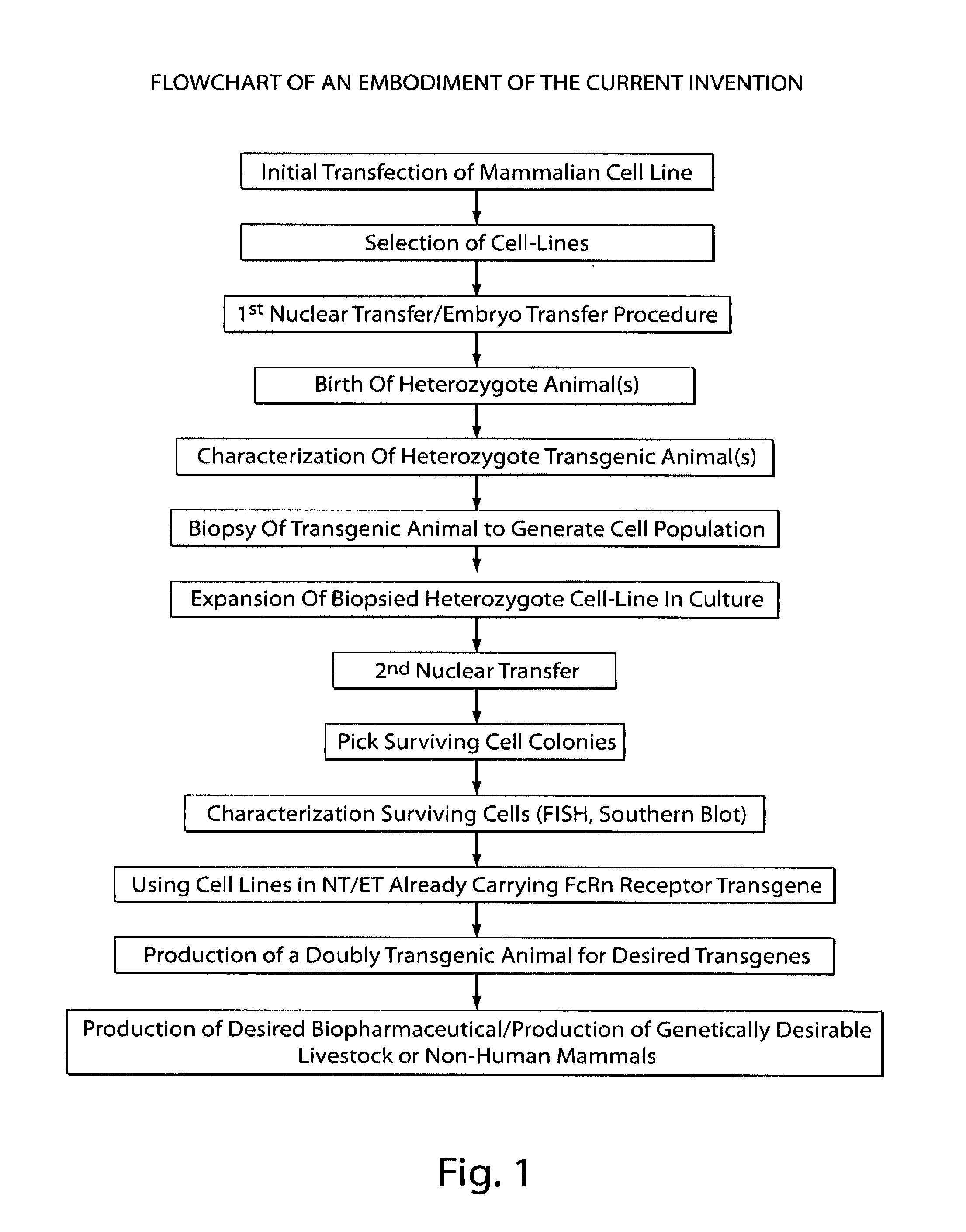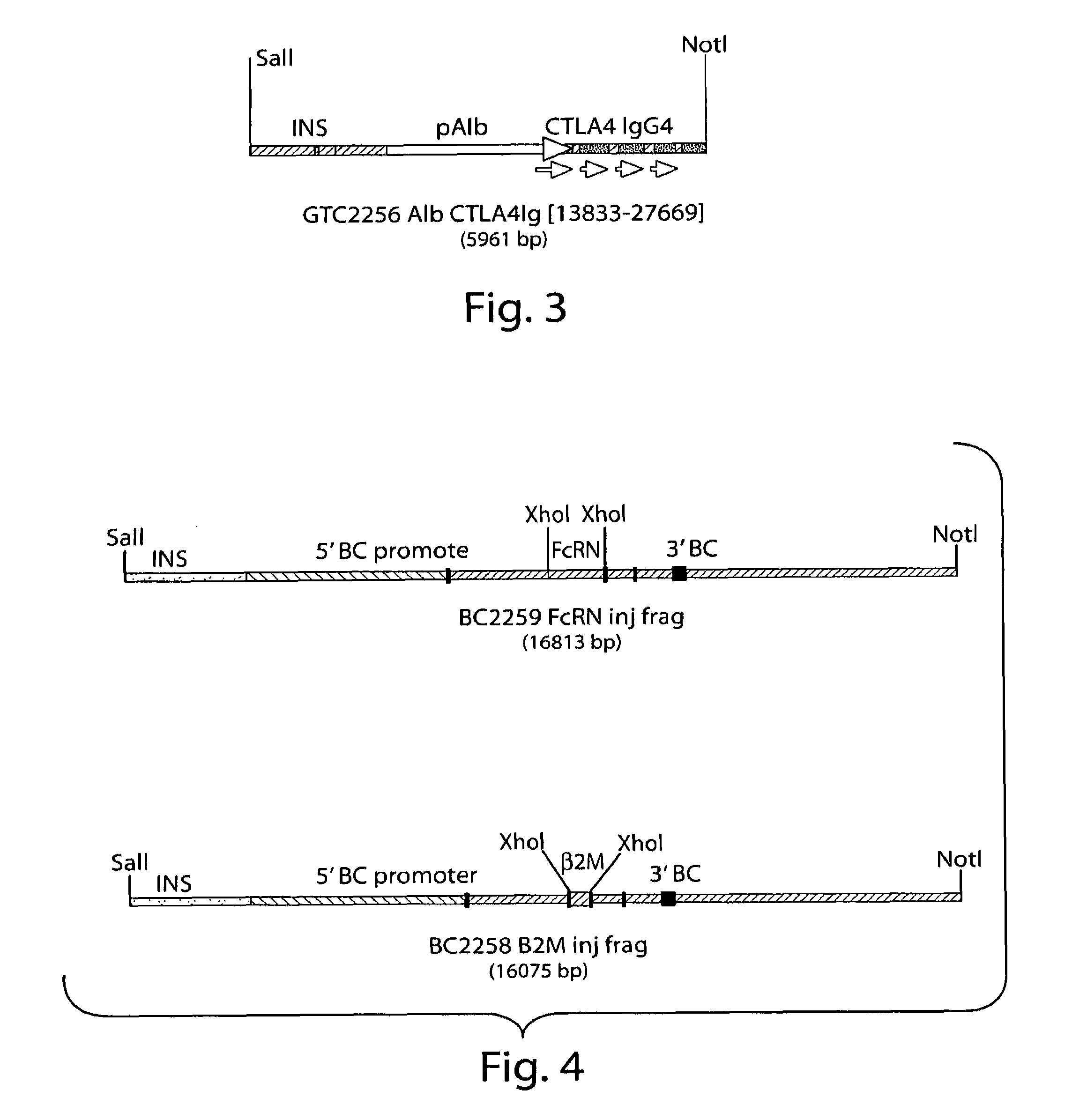Non-human transgenic mammal expressing a human FcRn on its mammary gland cells and expressing a transgenic protein-human Fc-domain fusion
a technology of transgenic mammal and human fcrn, which is applied in the field of protein production, can solve the problems of high expression level systems such as bacterial, yeast and insect cells for producing therapeutic proteins, and can be more expensive, so as to increase the level of sialation, increase the level of transgenic protein in the milk of the non-human mammal, and increase the level of transgenic protein
- Summary
- Abstract
- Description
- Claims
- Application Information
AI Technical Summary
Problems solved by technology
Method used
Image
Examples
example 1
A Method for the Production of Transgenic Mammals with Nuclear Transfer
Oocytes
[0110]Oocytes can be obtained at various times during an animal's reproductive cycle. Oocytes at various stages of the cell cycle can be obtained and then induced in vitro to enter a particular stage of meiosis. For example, oocytes cultured on serum-starved medium become arrested in metaphase. In addition, arrested oocytes can be induced to enter telophase by serum activation.
[0111]Oocytes can be matured in vitro before they are used to form a reconstructed embryo. This process usually requires collecting immature oocytes from mammalian ovaries, e.g., a caprine ovary, and maturing the oocyte in a medium prior to enucleation until the oocyte reaches the desired meiotic stage, e.g., metaphase or telophase. In addition, oocytes that have been matured in vivo can be used to form a reconstructed embryo.
[0112]Oocytes can be collected from a female mammal during superovulation. Briefly, oocytes, e.g., caprine oo...
example 2
A Method for the Production of Transgenic Mammals with Microinjection
Goat Species and Breeds
[0118]Swiss origin goats, e.g., the Alpine, Saanen, and Toggenburg breeds, are useful in the production of transgenic goats. Below exemplary steps for the production of transgenic goats are briefly described. These steps include superovulation of female goats, mating to fertile males and collection of fertilized embryos. Once collected, pronuclei of one-cell fertilized embryos are microinjected with DNA constructs. All embryos from one donor female are, in some embodiments, kept together and transferred to a single recipient female, if possible.
Goat Superovulation
[0119]The timing of estrus in the donors is synchronized on Day 0 by 6 mg subcutaneous norgestomet ear implants (Syncromate-B, CEVA Laboratories, Inc., Overland Park, Kans.). Prostaglandin is administered after the first seven to nine days to shut down the endogenous synthesis of progesterone. Starting on Day 13 after insertion of th...
example 3
G418 Selection for Recombinant Human FcRn Gene Insertion
[0131]Plate primary cells at 2×105 / 10 cm petri dish. Set up 2 petris for every concentration of G418. Optimum concentrations of G418 will vary from cell line to cell line, for example:[0132]1.2″[0133]1.5″[0134]2.0″[0135]2.5″[0136]3.0″
[0137]Add the drug at the same time you plate the cells. There is no need to let the cells settle down first. Feed plates daily for the next five days with fresh medium+drug. After ˜5 days most of the cells will be dead, so feeding can be dropped back to every other day or so. Pick 6-24 of the best looking clones from the highest concentration of G418 onto 24-well wells. Freeze and expand for DNA and karyotyping. Immobilize cells on filters for interphase FISH.
PUM
| Property | Measurement | Unit |
|---|---|---|
| diameter | aaaaa | aaaaa |
| concentration | aaaaa | aaaaa |
| concentration | aaaaa | aaaaa |
Abstract
Description
Claims
Application Information
 Login to View More
Login to View More - Generate Ideas
- Intellectual Property
- Life Sciences
- Materials
- Tech Scout
- Unparalleled Data Quality
- Higher Quality Content
- 60% Fewer Hallucinations
Browse by: Latest US Patents, China's latest patents, Technical Efficacy Thesaurus, Application Domain, Technology Topic, Popular Technical Reports.
© 2025 PatSnap. All rights reserved.Legal|Privacy policy|Modern Slavery Act Transparency Statement|Sitemap|About US| Contact US: help@patsnap.com



